Monkeemania: Confessions of a Second-Generation Monkees Fan!
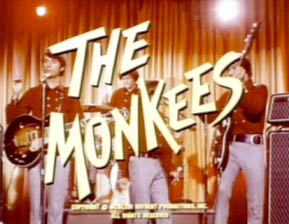 The early 1970’s were a turbulent time in United States history. The country was divided by many issues including a war in Vietnam and civil rights at home. As undecided as most Americans were on these issues, one thing was unanimously certain – The Monkees were not cool! The pre-fab pop group from the ’60’s had suffered a good deal of criticism at the height of their popularity and now that they were on a steady downhill slide they were an easy target for anyone with even the most limited knowledge of music or consumerism. As The Monkees entered the twilight of their original career as a musical group and media icons, they had found a seemingly final resting place in the one medium that would still embrace them – Saturday morning television.
The early 1970’s were a turbulent time in United States history. The country was divided by many issues including a war in Vietnam and civil rights at home. As undecided as most Americans were on these issues, one thing was unanimously certain – The Monkees were not cool! The pre-fab pop group from the ’60’s had suffered a good deal of criticism at the height of their popularity and now that they were on a steady downhill slide they were an easy target for anyone with even the most limited knowledge of music or consumerism. As The Monkees entered the twilight of their original career as a musical group and media icons, they had found a seemingly final resting place in the one medium that would still embrace them – Saturday morning television.
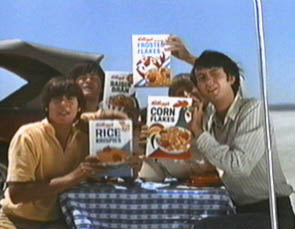 Anyone who spent their early, formative, years in the late ’60’s or early ’70’s will undoubtedly remember the ritual that was Saturday morning. The same children who had to be pried out of bed with a crowbar during the week for school would voluntarily catapult from under the covers an hour or two earlier than usual on this glorious day of the week. Saturday morning was a golden time, a five hour span from roughly 7AM until noon, when kids ruled the television airwaves. Some of the hardcore enthusiasts among us had learned that getting up too early meant suffering through the tail end of old black and white movies on Nite Owl Theater
Anyone who spent their early, formative, years in the late ’60’s or early ’70’s will undoubtedly remember the ritual that was Saturday morning. The same children who had to be pried out of bed with a crowbar during the week for school would voluntarily catapult from under the covers an hour or two earlier than usual on this glorious day of the week. Saturday morning was a golden time, a five hour span from roughly 7AM until noon, when kids ruled the television airwaves. Some of the hardcore enthusiasts among us had learned that getting up too early meant suffering through the tail end of old black and white movies on Nite Owl Theater 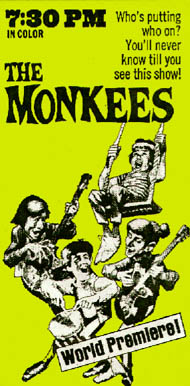 but if you slept in too late you missed the oddball shows like Thunderbirds or Popeye & Pals. Once locked in to this animated and live action utopia, preferably with one or two bowls of some cereal with a borderline illegal concentration of sugar, there was no self-respecting child who would move for anything outside a quick bathroom break until the disheartening sounds of Soul Train or the ABC Wide World of Sports broke our trance at noon! This was a ready made world for reruns of a fast paced, colorful, and inauspicious show like The Monkees.
but if you slept in too late you missed the oddball shows like Thunderbirds or Popeye & Pals. Once locked in to this animated and live action utopia, preferably with one or two bowls of some cereal with a borderline illegal concentration of sugar, there was no self-respecting child who would move for anything outside a quick bathroom break until the disheartening sounds of Soul Train or the ABC Wide World of Sports broke our trance at noon! This was a ready made world for reruns of a fast paced, colorful, and inauspicious show like The Monkees.
In 1968, following its cancellation after only two seasons, the 58 episodes of the NBC series The Monkees were sold into what was considered “first run” syndication. In an attempt to keep the series fresh and continue its use as a 30 minute commercial to sell records, many of the episodes were re-dubbed with newer songs to correspond to the most recent releases. The package went to CBS who immediately scheduled it as part of their Saturday morning lineup beginning in the fall of 1969. After an incredibly successful run for three seasons, the ABC network got their turn and managed to milk one more year out of the show before releasing it in 1973. The Monkees at this point were finished as a performing and recording act and their television series was shelved after having had more than a fair run.
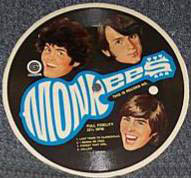 By 1975, The Monkees were considered has-beens by the general public and beneath contempt by most of the music industry. The record label they recorded for, Colgems, was defunct and only a hastily assembled collection of their supposed greatest hits (two of the ten songs were album tracks that had never even been released as singles) was available from the second tier Bell Records. In spite of this, Screen Gems decided to make the series available for general syndication in the hope that some audience was still interested before it dropped off the face of the Earth for good. WTOG 44 was one of the stations that picked up the series and ran it every summer for several years.
By 1975, The Monkees were considered has-beens by the general public and beneath contempt by most of the music industry. The record label they recorded for, Colgems, was defunct and only a hastily assembled collection of their supposed greatest hits (two of the ten songs were album tracks that had never even been released as singles) was available from the second tier Bell Records. In spite of this, Screen Gems decided to make the series available for general syndication in the hope that some audience was still interested before it dropped off the face of the Earth for good. WTOG 44 was one of the stations that picked up the series and ran it every summer for several years.
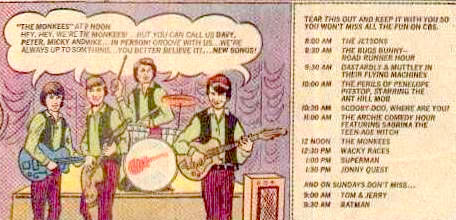 As a nine-year-old child, syndicated programming was one of the highlights of my day, especially in the summer time. I eagerly awaited the arrival of The Banana Splits, Lost in Space, Gilligan’s Island, and Get Smart each and every weekday. When The Monkees was added to this lineup I was instantly reacquainted with a show I was unable to truly appreciate a few years earlier. Now in addition to the slapstick antics, I was also entertained by some of the more involved humor and the music.
As a nine-year-old child, syndicated programming was one of the highlights of my day, especially in the summer time. I eagerly awaited the arrival of The Banana Splits, Lost in Space, Gilligan’s Island, and Get Smart each and every weekday. When The Monkees was added to this lineup I was instantly reacquainted with a show I was unable to truly appreciate a few years earlier. Now in addition to the slapstick antics, I was also entertained by some of the more involved humor and the music.
Unfortunately, for a second-generation Monkee fan at this time, there were no records in print, even the Bell greatest hits collection had quickly lapsed into obscurity. Asking for Monkees product at the local record store was like asking for a hot dog at a fancy steak house, it didn’t get you very far. It was actually only by accident that I even discovered that The Monkees released records, when a friend of mine threatened to break his younger sister’s copies if she didn’t leave him alone! From then on I was on one of my seemingly endless quests to at least make cassette tapes of any albums I could beg, borrow, or steal from any available source. I only managed to procure bad dubs of the first three Monkee LPs over the next couple of years before I discovered a miracle in a neighboring city – a used record store.
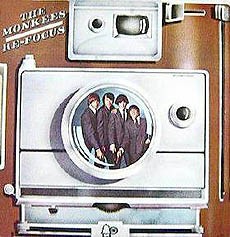 The very first time I set foot in Hyde and Zeke’s Records in Gainesville, Florida, I deposited several weeks of my hard earned allowance and withdrew my very own copies of six of the first seven albums The Monkees recorded (two thirds of their nine album total original output). Needless to say, the 45-minute ride home to my record player was almost unbearable and I proceeded to do everything I could to wear what was left of the grooves off these plastic treasures! The guy behind the counter was even caught up in my outdated admiration enough to give me an early issue of Goldmine magazine that featured The Monkees on the cover – for free.
The very first time I set foot in Hyde and Zeke’s Records in Gainesville, Florida, I deposited several weeks of my hard earned allowance and withdrew my very own copies of six of the first seven albums The Monkees recorded (two thirds of their nine album total original output). Needless to say, the 45-minute ride home to my record player was almost unbearable and I proceeded to do everything I could to wear what was left of the grooves off these plastic treasures! The guy behind the counter was even caught up in my outdated admiration enough to give me an early issue of Goldmine magazine that featured The Monkees on the cover – for free.
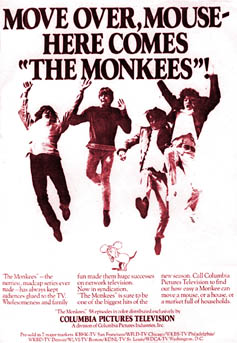 I spent the next several summers blissfully enjoying the weekday escapades and musical performances of The Monkees until WTOG finally retired them in the early 80’s. These were still the primitive “BV” days (Before Video recorders) so the best I could do was tape the shows off the television onto audio cassettes. It would take me many more years before I finally completed my Monkees record collection and rounded up copies of the episodes on video tape but it was a fun journey while it lasted.
I spent the next several summers blissfully enjoying the weekday escapades and musical performances of The Monkees until WTOG finally retired them in the early 80’s. These were still the primitive “BV” days (Before Video recorders) so the best I could do was tape the shows off the television onto audio cassettes. It would take me many more years before I finally completed my Monkees record collection and rounded up copies of the episodes on video tape but it was a fun journey while it lasted.
Coming next week to a Retrorama column near you –- 33 1/3 Revolutions Per Monkee: An In-Depth Look at the Monkees’ Recording History.
